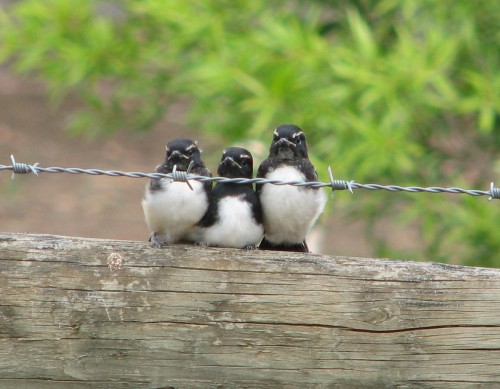It’s nesting time again
It’s that time of year again in Australia – spring nesting season.
Birds everywhere are making nests, sitting on eggs in nests or feeding young just out of the nest. In southern Australia – the region I am most familiar with – the “spring” nesting season stretches from the winter months of July and August, through the entire season of spring (September – November) and even well into summer (December – January).
Having confused all of my overseas readers I should explain three things:
- Most of the breeding occurs in the spring months.
- Some species – like our honeyeaters – will nest multiple times, raising 2 or more broods a season.
- Some species will even raise as many as five broods over a six month period.
Being late September nesting is in full swing here on our 5 acre (2 hectare) property in Murray Bridge, South Australia. The following is a quick annotated list of those species I have observed in the breeding mode in recent weeks:
Willie Wagtail: our resident birds have been very quiet and I suspected that they had a nest somewhere but I only found it yesterday. It contained two eggs. The photo above shows a fluffy family of Willie Wagtails just out of the nest a few years ago.
New Holland Honeyeater: last week I saw two parent birds fussing over and feeding two fledglings just out of the nest and barely able to flutter, let alone fly.
Red Wattlebird: I saw one bird sitting on a nest high in one of our trees but haven’t checked it in recent days. Other wattlebirds in our garden are being bossier than usual, so I guess that there are young around somewhere.
House Sparrow (introduced species): they always seem to be mating and nesting, so nothing unusual there.
Common Starling (introduced): the resident dozen or so birds all seem to have taken up occupation of a number of tree hollows in our mallee scrub, but I haven’t yet heard the persistent calls of the nestlings begging to be fed.
Mallee Ringneck parrots: our resident birds were feeding young a month or so ago, and I have seen them constantly investigating a tree hollow. Earlier this week we saw two of them mating, so the next brood could be on the way soon.
Cuckoos: I haven’t seen any cuckoos yet this season but I have heard Horsfield’s Bronze-cuckoos calling several times, so they could possibly be nesting too.
Galah: I’m not sure what our Galahs are doing. They come to a hollow in an old growth mallee tree near our clothes line and enter the hollow every day but nothing else seems to be happening. This has happened now for several years so I will just have to keep an eye on proceedings.
Australian Magpie: this is a really puzzling one. The resident magpies showed all the right activities a few months ago when they defended their territory but since then everything has gone quiet. We daily see several birds feeding around the garden and in the paddock, but I have yet to locate a nest. Very strange.
I have highlighted just 9 species in this article. Over the last 30 years I have observed many more species either breeding, or feeding young, on our property. I am quite confident that there would be other species currently nesting somewhere here, possibly including:
- Grey Shrike-thrush
- Common Blackbird (introduced)
- Spotted Turtledove (introduced)
- Crested Pigeon
- Yellow-rumped Thornbill
- Weebill
- Spotted Pardalote
- Striated Pardalote
- Mistletoebird
- White-plumed Honeyeater
- Spiny-cheeked Honeyeater
- Singing Honeyeater
- Little Raven
- Pacific Black Duck (they bring the ducklings to our swimming pool!
- Superb Fairy-wren
- Australian Magpie-lark
- Grey Butcherbird
Further reading:
Click on the following article headings to read about successful breeding attempts in past years:
- We have baby Willie Wagtails
- New Holland Honeyeater nest
- Red wattlebirds with young
- House Sparrows eating berries
- Very Common Starlings – nesting
- Mallee Ringnecks nesting
- Horsfield’s Bronze-cuckoo
- Possible Galah nesting attempt
- Baby Magpie – this is the most popular article on this site with nearly 500 reader comments.
Spotted Turtledove nesting
One morning last week while having breakfast I noticed a Spotted Turtledove flying frequently to a melaleuca bush near our sunroom. As we watched it flew down to the ground several times, each time collecting fine twigs and then it carried the twigs back to the nest. This went on sporadically over the nest few days.
Two days ago I searched the bush and eventually found the nest, complete with the female sitting on the nest. Like most doves and pigeons the nest is a flimsy affair, consisting of barely enough twigs to hold the eggs. How the babies manage to stay in the nest beats me. Mind you, I will give the birds full points for hiding this nest. It is very hard to find as it’s located in some very thick foliage. Should make photography of the babies quite challenging – perhaps not possible. They are easily spooked from the eggs or young so I might just let them get on with hatching the eggs and later feeding the young.
Active Yellow-rumped Thornbills
One of the common resident bird species in our garden and on our five acre block is the Yellow-rumped Thornbill. Every day we see flocks of 8-10 foraging on the ground in most parts of our property. I love seeing them hopping around or flying low across the garden, their bright yellow tails brilliant in the sunshine. They are regular visitors to the bird baths too during the warmer months of the year.
At present they are extremely active. The warmer spring weather is with us and so they are probably nesting somewhere too. It’s just that I haven’t yet found their nest.
Related articles:




